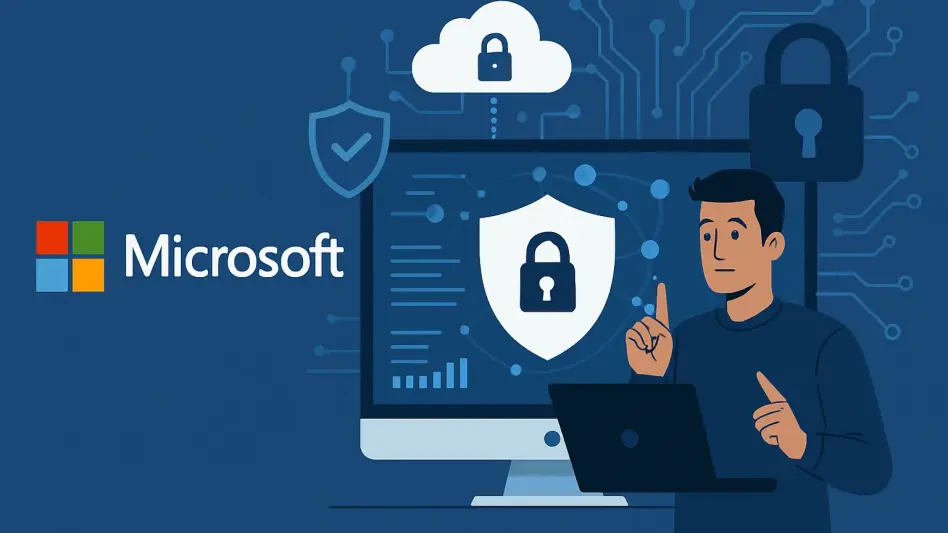In an era where cyber threats loom larger than ever, Microsoft’s latest Patch Tuesday release for August has emerged as a pivotal moment for organizations and individuals striving to secure their digital environments against an onslaught of vulnerabilities. With a staggering 107 flaws addressed across a spectrum of products like Windows, Office, SharePoint, and Azure Stack Hub, this update underscores the relentless pace of cybersecurity challenges. The urgency is palpable, especially with a publicly disclosed zero-day vulnerability in the Windows Kerberos authentication protocol grabbing headlines for its potential to enable devastating privilege escalation. As digital infrastructures become increasingly complex, this release serves as a critical reminder of the importance of timely updates and robust defense strategies to stay ahead of sophisticated threats.
Addressing High-Severity Vulnerabilities
Tackling Zero-Day Threats in Core Systems
The spotlight of this month’s update falls on a severe zero-day flaw within the Windows Kerberos authentication protocol, identified as CVE-2025-XXXX, which poses a significant risk of privilege escalation across Active Directory environments. Although no active exploitation has been confirmed, the public disclosure of this vulnerability amplifies the need for immediate action to prevent potential domain-wide compromises. Cybersecurity experts have noted that such flaws, if left unaddressed, could mirror the catastrophic impacts of past attacks that crippled networks globally. The urgency to patch this issue cannot be overstated, as it forms the backbone of secure authentication in countless enterprise systems, making it a prime target for malicious actors seeking to infiltrate sensitive environments.
Beyond the Kerberos vulnerability, Microsoft has also prioritized fixes for 36 remote code execution (RCE) flaws, with 13 classified as critical, affecting components such as Windows GDI+, SharePoint, and Azure Stack Hub. These high-severity bugs carry the potential for widespread damage, drawing comparisons to historical wormable threats that once paralyzed entire industries. The emphasis on rapid deployment of these patches stems from the understanding that attackers often exploit such vulnerabilities within days of disclosure. Enterprises are strongly advised to integrate automated patching mechanisms to manage the sheer volume of updates while minimizing the window of exposure to these dangerous exploits.
Mitigating Broader Security Risks
Alongside the headline-grabbing zero-day issue, the update addresses a diverse array of threats, including elevation of privilege flaws, information disclosure issues, and denial-of-service vectors that collectively paint a complex threat landscape. Each of these vulnerabilities, while varying in severity, contributes to the overarching risk of system compromise if not rectified promptly. The multifaceted nature of these flaws highlights the necessity for comprehensive patch management strategies that go beyond merely addressing the most critical issues. Security teams must adopt a layered approach to ensure no gap is left unaddressed, as even seemingly minor flaws can serve as entry points for broader attacks.
Another pressing concern is the critical RCE vulnerability in Windows GDI+, tracked as CVE-2025-53766, which echoes past exploits that have historically led to significant breaches. This flaw, combined with others in the update, reinforces the high stakes of maintaining up-to-date systems. Recommendations from industry analysts suggest prioritizing fixes based on CVSS scores to tackle the most dangerous threats first. Additionally, leveraging cumulative updates like KB5063878 for Windows 11, which bundle security and stability enhancements, can streamline the patching process. This strategic focus ensures that systems remain resilient against evolving threats while maintaining operational continuity.
Preparing for Future Security Challenges
Navigating the End of Windows 10 Support
A looming deadline adds another layer of urgency to this month’s Patch Tuesday, as free security support for Windows 10 is set to expire in October. This cutoff raises significant concerns for millions of users and organizations facing hardware compatibility barriers in transitioning to Windows 11. Unpatched devices risk becoming prime targets for cybercriminals, reminiscent of the vulnerabilities exposed during the end-of-life phase for older operating systems. The availability of paid Extended Security Updates offers a temporary reprieve, but accessibility and cost remain hurdles for smaller entities and individual users, amplifying the need for strategic planning to mitigate long-term risks.
For those unable to upgrade immediately, exploring alternative solutions or interim security measures becomes imperative to safeguard systems post-support. Community discussions and expert analyses highlight the global cybersecurity gap, particularly in regions reliant on legacy hardware, which could widen without proactive intervention. Enterprises are encouraged to test updates in staged environments to avoid deployment issues, while end users must weigh the benefits of upgrades against the risks of operating unsupported systems. This situation underscores the importance of staying ahead of emerging threats through informed decision-making and resource allocation.
Building a Resilient Defense Strategy
The sheer scale of this update cycle, combined with broader industry trends, signals a busy period for security teams tasked with maintaining system integrity across sectors. Alongside Microsoft’s efforts, patches from other major vendors indicate a collective push to address vulnerabilities in a rapidly evolving threat landscape. A unified defense strategy that incorporates automated patching, threat intelligence integration, and user education is essential to handle the volume of updates and anticipate potential exploits. Such an approach minimizes human error and strengthens overall security posture against sophisticated attacks that continue to adapt.
Reflecting on the August Patch Tuesday, the critical fixes implemented served as a vital bulwark against 107 vulnerabilities, including a high-risk Kerberos zero-day and numerous severe RCE flaws. The urgency of these patches was matched by the looming end of Windows 10 support, which heightened risks for unpatched systems. Moving forward, organizations and users must prioritize actionable steps, such as adopting automated update tools, subscribing to extended support where feasible, and planning upgrades to newer platforms. Continuous monitoring for post-patch issues, especially in complex products like SharePoint, remains crucial. As cyber threats grow in complexity, maintaining vigilance and embracing a proactive, layered security framework will be key to ensuring digital resilience.








